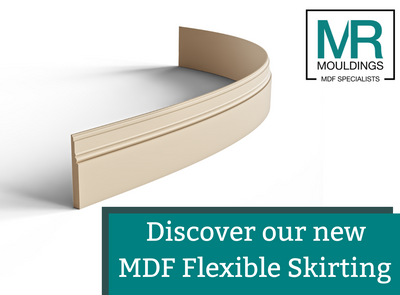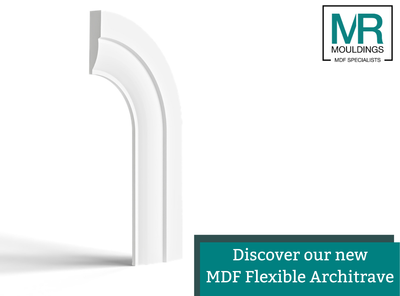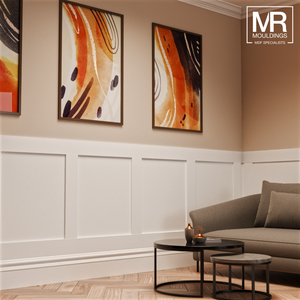
How Is MDF Made? Behind the Boards at MR Mouldings
MDF is one of the most widely used materials in modern interior joinery, and for good reason. It’s smooth, stable, and cost-effective, making it ideal for skirting boards, architraves, door linings, and decorative trims.
But what exactly is MDF, and how is it made?
MDF (Medium-Density Fibreboard) is made by breaking down wood fibres into a fine consistency, then mixing them with wax and resin. This mixture is compressed under heat and pressure to form smooth, dense boards, ideal for mouldings, trims, and furniture, especially when moisture-resistant variants are used for added durability.
At MR Mouldings, we specialise in high-quality, moisture-resistant MDF mouldings. Our customers often ask about the materials and processes behind the products we supply, so here’s a detailed look into how MDF is made and why it performs so well in your home.
What Is MDF?
MDF stands for Medium-Density Fibreboard, a type of engineered wood product. It’s made by breaking down wood fibres into a fine consistency, then bonding them together under heat and pressure with resin to form smooth, uniform boards.
Compared to natural timber, MDF is:
-
Knot-free and smooth – perfect for painting
-
Highly stable – no warping, cracking, or twisting
-
Ideal for machining – great for detailed mouldings and profiles
-
More affordable – without compromising on finish
What Is MDF Made From?
The core ingredients of MDF are simple:
-
Fine wood fibres – usually from softwood byproducts or recycled wood waste
-
Wax and resin – acting as a binder to hold the fibres together
-
Heat and pressure – used to compress the fibres into dense, solid panels
Modern MDF is manufactured to strict environmental and safety standards, including low-formaldehyde options (E1/E0 rated) for safe use in homes and commercial spaces.
How Is MDF Made? Step-by-Step
1. Raw Material Collection
MDF starts with wood chips, sawdust, and softwood offcuts, often byproducts from sawmills. This helps reduce waste and maximise the use of timber resources.
2. Fibre Refinement
The wood material is softened with steam and broken down into very fine wood fibres using mechanical refining machines.
3. Resin and Wax Application
The refined fibres are blended with wax and a synthetic resin binder. This step is critical for giving MDF its strength and stability. For moisture-resistant MDF, a special resin is used to reduce water absorption.
4. Forming the Mat
The mixture is formed into a fluffy, even mat of fibres. This mat is layered to the approximate size of the final board.
5. Pressing
The mat is compressed under intense heat and pressure in a hydraulic press. This step gives MDF its density and smooth surface.
6. Cooling, Trimming and Sanding
Once pressed, the boards are cooled, cut to size, and sanded to ensure a perfect finish.
7. Quality Control
Each batch of MDF is tested for:
-
Density and strength
-
Moisture content
-
Surface quality
-
Formaldehyde emissions (for safety compliance)
What Makes Moisture-Resistant MDF Different?
Standard MDF is suitable for dry environments, but for kitchens, bathrooms, and high-humidity areas, moisture-resistant MDF (MR MDF) is the smarter choice.
MR MDF:
-
Uses special resin formulations to repel moisture
-
Reduces the risk of swelling or degradation in damp areas
-
Offers greater durability for everyday wear and tear
-
It is standard across all mouldings at MR Mouldings
Whether you’re installing skirting in a utility room or trims in a bathroom, MR MDF gives you peace of mind.
Why Is MDF So Popular for Mouldings?
At MR Mouldings, we believe MDF is the best material for most internal joinery, especially when a painted finish is desired. Here’s why:
-
Smooth and knot-free: No grain means a cleaner look and a perfect paint finish
-
Highly machinable: Allows for precise profiles and detailed designs
-
Stable and consistent: Doesn’t warp or expand like solid wood
-
Cost-effective: Offers excellent value for both DIYers and professionals
It’s no surprise that most of the UK’s skirting boards and trims are made from MDF, especially when moisture resistance is built in from the start.
Is MDF Environmentally Friendly?
While MDF is a manufactured product, it has several eco-conscious advantages:
-
Made from recycled or waste wood fibres
-
Minimises the need for solid timber harvesting
-
Available in low-formaldehyde options (look for E1 or E0 ratings)
-
Lightweight and transport-efficient, reducing emissions in shipping
At MR Mouldings, we source only high-quality, responsibly made MDF to ensure the best performance and safety for your home.
Why Choose MR Mouldings’ MDF Products?
We don’t just sell MDF; we work with it every day, supplying moisture-resistant MDF mouldings to homeowners, tradespeople, and designers across the UK.
Here’s what sets us apart:
-
Moisture-resistant MDF as standard
-
Crisp profiles and smooth finishes for painting
-
High manufacturing consistency, no defects, no warping
-
A wide range of skirting, architraves, door linings and trims
-
Friendly, knowledgeable service from a team that truly understands the product
Whether you’re refreshing a single room or working on a full renovation, we’re here to help you get the details right.
FAQs
What is MDF made from?
MDF is made from fine wood fibres, wax, and resin, which are compressed under heat and pressure to form solid, smooth panels.
How is moisture-resistant MDF different?
It uses a special resin binder that repels moisture, making it suitable for damp or humid environments like kitchens and bathrooms.
Is MDF safe to use at home?
Yes. Modern MDF is manufactured to strict safety standards, with low formaldehyde emissions for safe indoor use.
Is MDF better than wood for skirting?
For painted finishes, MDF offers a smoother surface and greater stability than solid wood, especially in changing temperatures or humidity.
Does MDF swell when wet?
Standard MDF can swell if exposed to water, but moisture-resistant MDF significantly reduces this risk.
Final Thoughts
MDF is engineered to be strong, smooth, and reliable, qualities that make it ideal for interior mouldings. Understanding how it’s made only adds to its appeal, especially when you see how much care goes into each board.
At MR Mouldings, we’re proud to supply moisture-resistant MDF mouldings that perform as beautifully as they look. Explore our range online or get in touch with our team for advice, samples, and fast UK delivery.




